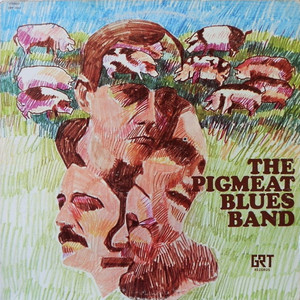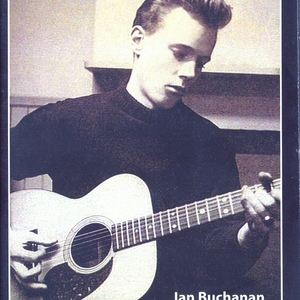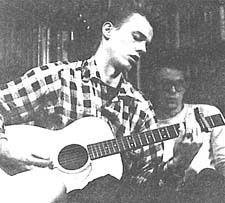Buchanan, Ian
Websites:
http://www.windingboy.com/
Origin:
Toronto, Ontario - Forest Hills, Queens, New York City, NY, USA
Biography:
Ian was born in Ontario, Canada on November 10, 1939 to a young single woman of a family of cabinet makers; his mother gave him up for adoption at birth. Ian was adopted through the Spence-Chapin adoption agency by the Buchanan family who lived in Forest Hills, Queens, New York City. The Buchanans had already adopted a two year older boy, named Richard. Mr. And Mrs. Buchanan were newspaper journalists (Ian jokingly referred to them as "hard bitten"); at some point, Ian's mother became editor of Parents Magazine. Ian had photographs of himself as a child posing for an article in the magazine. From a fairly early age Ian felt that he was different from his adoptive family and he felt more alienated as he grew up. We learned his family background when we consulted the adoption agency because Ian had developed a mild diabetes and wanted to know about his family medical history. The story of his biological mother's family gave him some explanation of why he had always felt so different from the other Buchanans. Ian's adoptive father died when Ian was in his mid-teens; Ian said he felt somewhat closer to his father than his mother, but experienced both as cold, distant, middle class strivers who didn't understand him or his interest in the blues.
Ian took up the guitar in his teens and developed an early interest in what was then called the country blues, becoming a passionate collector of old 78s pretty much unknown to anyone else, re-recording them on his professional reel to reel tape recorder. When I knew him (1961-1967) he had an enormous collection of carefully catalogued tapes of old 78s of then largely unknown of blues artists from the 30s and 40s. In his late teens he sought out Reverend Gary Davis (who lived in the South Bronx at that time) and began lessons with him; he studied with Davis off and on for maybe 5 years. Ian remained close to Davis for many years after he stopped studying with him and would visit him at his house and also occasionally attended church services when Davis was preaching. Davis in turn was very fond of Ian, often laughingly referring to him as "my white son." Davis was not his only influence, however. Ian's tastes in the blues were broad ranging from Lonnie Johnson, Blind Willie Johnson, Blind Blake, Blind Lemon Jefferson, Leroy Carr/Scrapper Blackwell (Blues before Sunrise) , Furry Lewis, and particular songs by Big Bill Broonzy (especially Keys to the Highway), Hopkins and everyone in between. Ian's taste in the blues was for harmonically complex but understated blues; he disliked electric guitar (although eventually he became interested in playing it) and what he viewed as over the top blues performers. Although Ian was very musical, easily picking up instruments (e.g. piano, harmonica, auto-harp), he could concentrate for days or weeks on one musician, dissecting his style bit by bit until he felt he had mastered it. He had an extensive repertoire; a few of the songs he routinely played were:
Keep on Truckin' Mama
How Long Blues
That'll Never Happen No More
Candy Man
Silver City Bound
I'm a Ram Rod Daddy
Keep Your Lamp Trimmed and Burning
Ian made three recordings: on Elektra album (EKS-7264; 1963) "The Blues Project" he sang "Winding Boy;" "Pigmeat Blues Band: Whatever Happened to Ian Buchanan?" (GRT 10013; 1967) and he sings and plays "Hesitation Blues" on the recently released "gary davis style" (InsideSounds CD 508). The "Pigmeat Blues Band" album includes recordings of "Kind Hearted Woman", "Like a Circle Around the Sun" and "Sweet, Sweet Marie."
Ian began college at NYU's engineering school but then in 1958 transferred to Antioch College in Yellow Springs, Ohio - a school that more closely matched his own unconventional style. At that time Antioch attracted a lot of kids from New York City who were talented in the sciences and the arts. It was politically left wing. Students at Antioch viewed themselves as an outpost of "the city" (NYC) both because so many were from there and because so many held co-op jobs in New York through Antioch's work-study program. When Ian began at Antioch, there was a lot of interest in bluegrass but much less in the blues; there were few white acoustic blues guitarists. Ian quickly became a kind of legend on campus - partly because of his James Dean style (black leather jacket, rolled tee-shirts with a pack of Camels held by the roll, well worn blue jeans and engineer boots) and partly because of his brilliant blues guitar. Although very bright, Ian was not much interested in scholastic achievement nor in college life beyond music making. There was a lot of the latter at Antioch but not enough to keep Ian there for long; he dropped out in 1959. He moved back to his family home in Queens and began performing in Greenwich Village: Goerde's Folk City, Caf Bizarre and Caf Wha among others. Ian liked performing for an appreciative, knowledgeable audience but he found much of the club scene pretentious and irritating. One of his favorite stories was of a NY Times critic who heard him play and said foolishly, "Wow that sounds like really old time Negro music, where did you learn it?" Ian's sardonic reply "From an old time Negro" cut short any further conversation. On the other hand the musical scene in the late 50s in Greenwich Village was exciting because other white blues guitarists were emerging as well, people like Dave Van Ronk, Danny Kalb, John Sebastian, and Spider John Koerner. There was a very active folk music scene as well (Bob Dylan also played at Goerde's which had a Monday night open mike policy) but Ian was never interested in folk music, although he enjoyed and could play bluegrass. During this period he also worked at a therapeutic residential school for troubled inner city kids. Ian had a strong interest in troubled adolescents because he had been one himself; he had not graduated from his local public high school but from a private school in Manhattan for troubled adolescents.
Ian returned to Antioch in the summer of 1961. Of course his legend proceeded him and everyone on the campus eagerly anticipated his return. He resumed playing Friday nights at the local bakery - he had an arrangement with the baker that Ian would play all night to entertain the baker as he baked. Anyone could come listen and occasionally other musicians would join in. Ian was a very generous musician. He liked playing with others who were as serious as he was and he enjoyed teaching newcomers. It was at Antioch that he taught and played with Jorma Kaukonen (Jefferson Airplane and Hot Tuna) and John Hammond, Jr.
As graduation loomed, Ian struggled to figure out what to do. He had no interest in continuing in psychology (his undergraduate major) but also didn't want to return to the club scene in Greenwich Village which he felt was degrading. He was accepted in Guitar Performance at the Mannes College of Music; his plan was to study classical guitar with the idea he might be able to make a living performing and teaching. He was also eager to return to his hometown, Queens and pick up his old friendships. Ian lasted about a year at Mannes. He actually enjoyed it as much as he ever enjoyed any educational setting and he admired his guitar teacher. He developed a small cyst in his right hand, however, which compromised his ability to play classical guitar. He was told in a medical consultation that although the cyst could be removed the operation itself would probably also damage his playing ability. Ian was shattered. He briefly studied jazz guitar and then returned to his deepest passion, the blues. He continued playing the blues until his death. Around 1965 he turned to the electric guitar and formed the first of many small blues bands with his oldest friend, Marty Brennan; his hope was that traditional blues electrified in a band would find him a wider audience than solo acoustic work.
Ian was a loving, generous man. He was never cruel or mean but would simply withdraw from social contact if he found the other person hard to bear. He was most comfortable either with his close friends or performing, but became ill at ease with large groups or people he did not know very well. He was laconic, finding it hard to express his deepest feelings except through his music. He had a wonderful, whimsical sense of humor that often involved word play and puns. He was a person of contradictions: although he dressed in a sort of 50s juvenile delinquent style, his tee shirts actually were imported from England and he had a standing charge account at Brooks Brothers. He liked performing as in playing with and for other musicians, but had little interest in self promotion. His career in music always depended on his reputation and his friends pursuing gigs for him. Ian had a number of interests besides music. He was an avid ham radio operator, often staying up late into the night contacting other radio buffs around the world. He was entranced by the beauty of tropical fish and had a large aquarium of many different species he tended carefully. He loved good design whether in furniture, guitars or well built engines. He once owned an Austin-Healy but sold it because it spent so much time up on blocks; he replaced it with a VW Beetle which he loved because he could fix the engine himself. Equally he loved a well designed motorcycle, at one point owning both a large touring BSA and a smaller off road bike. He loved riding his bikes but he also loved spending long hours cleaning and tuning their engines.
In June of 1970 Ian suffered a terrible fall that left him a paralplegic. Although in constant pain and sometimes depressed, he continued to perform.
To a small circle of New York based blues and guitar enthusiasts in the early 1960s, Ian Buchanan was one of the greatest then-living masters of traditional blues.
Ian's teen years were devoted to collecting recordings of country blues and mastering guitar techniques by various black players of the '30s and '40s. He studied with Reverend Gary Davis for about five years, leading to a lasting and affectionate friendship, in which Davis laughingly referred to Ian as "his white son."
After a brief stint at NYU, Ian transferred to Antioch College in 1958, where his dramatic, complex playing and singing caught the interest of students and musicians at the forefront of the folk revival. He consolidated his mastery of tunes by a broad range of traditional artists, ranging from Lonnie Johnson to Big Bill Broonzy, and while at Antioch he taught guitar technique to fellow students John Hammond, Jr. and Jorma Kaukonen.
Buchanan's playing of country blues was his passion. His mastery transcended "authentic" and developed into a sound that was personal, unique and brilliant. But as remarkable as his playing and singing became, he remained an "artists artist", indifferent to self promotion and content to be the center of a small circle of friends and admirers. Reserved, in his style and singing in a "natural" voice, his guitar playing showed him to be somewhat ahead of his time. He would not hesitate to show and teach his finger picking technique to anyone with a serious interest. His voice changed in intensity and tone, as one can hear in his Home Recordings, after a serious fall in early 1970 that left him paraplegic for the last twelve years of his life.
b. November 10, 1939 in Ontario, Canada
d. December 9, 1982
-Kirsten Dahl, May 19, 2005




